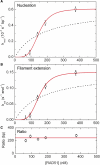Real-time assembly and disassembly of human RAD51 filaments on individual DNA molecules
- PMID: 17709342
- PMCID: PMC2034483
- DOI: 10.1093/nar/gkm629
Real-time assembly and disassembly of human RAD51 filaments on individual DNA molecules
Abstract
The human DNA repair protein RAD51 is the crucial component of helical nucleoprotein filaments that drive homologous recombination. The molecular mechanistic details of how this structure facilitates the requisite DNA strand rearrangements are not known but must involve dynamic interactions between RAD51 and DNA. Here, we report the real-time kinetics of human RAD51 filament assembly and disassembly on individual molecules of both single- and double-stranded DNA, as measured using magnetic tweezers. The relative rates of nucleation and filament extension are such that the observed filament formation consists of multiple nucleation events that are in competition with each other. For varying concentration of RAD51, a Hill coefficient of 4.3 +/- 0.5 is obtained for both nucleation and filament extension, indicating binding to dsDNA with a binding unit consisting of multiple (> or =4) RAD51 monomers. We report Monte Carlo simulations that fit the (dis)assembly data very well. The results show that, surprisingly, human RAD51 does not form long continuous filaments on DNA. Instead each nucleoprotein filament consists of a string of many small filament patches that are only a few tens of monomers long. The high flexibility and dynamic nature of this arrangement is likely to facilitate strand exchange.
Figures







Similar articles
-
Human Rad51 filaments on double- and single-stranded DNA: correlating regular and irregular forms with recombination function.Nucleic Acids Res. 2005 Jun 8;33(10):3292-302. doi: 10.1093/nar/gki640. Print 2005. Nucleic Acids Res. 2005. PMID: 15944450 Free PMC article.
-
Fluorescent human RAD51 reveals multiple nucleation sites and filament segments tightly associated along a single DNA molecule.Structure. 2007 May;15(5):599-609. doi: 10.1016/j.str.2007.04.003. Structure. 2007. PMID: 17502105
-
Visualizing the assembly of human Rad51 filaments on double-stranded DNA.J Mol Biol. 2006 Oct 27;363(3):713-28. doi: 10.1016/j.jmb.2006.08.046. Epub 2006 Aug 22. J Mol Biol. 2006. PMID: 16979659
-
Regulation of DNA strand exchange in homologous recombination.DNA Repair (Amst). 2010 Dec 10;9(12):1264-72. doi: 10.1016/j.dnarep.2010.09.014. DNA Repair (Amst). 2010. PMID: 20971042 Review.
-
Single-molecule imaging brings Rad51 nucleoprotein filaments into focus.Trends Cell Biol. 2010 May;20(5):269-76. doi: 10.1016/j.tcb.2010.02.004. Epub 2010 Mar 17. Trends Cell Biol. 2010. PMID: 20299221 Free PMC article. Review.
Cited by
-
Homologous recombination defects and how they affect replication fork maintenance.AIMS Genet. 2019 Apr 3;5(4):192-211. doi: 10.3934/genet.2018.4.192. eCollection 2018. AIMS Genet. 2019. PMID: 31435521 Free PMC article. Review.
-
Mechanistic modelling supports entwined rather than exclusively competitive DNA double-strand break repair pathway.Sci Rep. 2019 Apr 23;9(1):6359. doi: 10.1038/s41598-019-42901-8. Sci Rep. 2019. PMID: 31015540 Free PMC article.
-
Monte carlo simulations of protein assembly, disassembly, and linear motion on DNA.Biophys J. 2008 Nov 15;95(10):4560-9. doi: 10.1529/biophysj.108.135061. Epub 2008 Jul 25. Biophys J. 2008. PMID: 18658217 Free PMC article.
-
A comparative analysis of Dmc1 and Rad51 nucleoprotein filaments.Nucleic Acids Res. 2008 Jul;36(12):4057-66. doi: 10.1093/nar/gkn352. Epub 2008 Jun 4. Nucleic Acids Res. 2008. PMID: 18535008 Free PMC article.
-
Architectural plasticity of human BRCA2-RAD51 complexes in DNA break repair.Nucleic Acids Res. 2017 May 5;45(8):4507-4518. doi: 10.1093/nar/gkx084. Nucleic Acids Res. 2017. PMID: 28168276 Free PMC article.
References
-
- West SC. Molecular views of recombination proteins and their control. Nat. Rev. Mol. Cell Biol. 2003;4:435–445. - PubMed
-
- Wyman C, Kanaar R. Homologous recombination: Down to the wire. Curr. Biol. 2004;14:R629–R631. - PubMed
-
- Conway AB, Lynch TW, Zhang Y, Fortin GS, Fung CW, Symington LS, Rice PA. Crystal structure of a Rad51 filament. Nat. Struct. Mol. Biol. 2004;11:791–796. - PubMed
-
- Yu X, VanLoock MS, Yang S, Reese JT, Egelman EH. What is the structure of the RecA-DNA filament? Curr. Protein Pept. Sc. 2004;5:73–79. - PubMed
Publication types
MeSH terms
Substances
LinkOut - more resources
Full Text Sources
Research Materials

